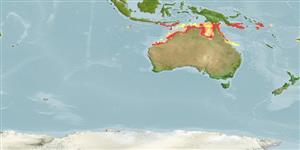Environment: milieu / climate zone / depth range / distribution range
Ekologi
laut bentopelagis, usually 8 - 10 m (Ref. 27621). Tropical; 9°S - 21°S
Western Pacific: northern Australia. Almost certainly present in southern Papua New Guinea.
Size / Weight / umur
Maturity: Lm ? range ? - ? cm
Max length : 32.0 cm TL jantan/; (Ref. 3132); common length : 20.0 cm TL jantan/; (Ref. 27621)
Duri punggung (Keseluruhan (total)): 8; duri punggung lunak (Keseluruhan (total)): 14; Duri dubur 3; Sirip dubur lunak: 12. Three dark vertical bands from nape, the first through eye, the second along the edge of the preopercle and the third down to the base of the pectoral fins; Dorsal fin with 8 spines increasing in length from a small anterior spine to a long posterior one; soft dorsal rays 14, much higher than spinous part and with the anterior ray produced into a short filament, the third ray prolonged into a long simple filament which extends past the caudal fin and the fourth and fifth rays also extended to beyond the hypural joint; anal fin with 3 slender spines and 12 soft rays, the second ray prolonged beyond the caudal fin and the third ray almost as long in small specimens.
Inhabit trawling grounds. Found more frequently in moderate depths on the continental shelf particularly close to submerged reefs or rough bottom (Ref. 27621). Feed mainly on crustaceans (Ref. 27621). Some cuttlefish are also taken (Ref. 27621).
Life cycle and mating behavior
Kematangan | Reproduksi, perkembang biakan | Pemijahan | telur-telur | Fecundity | Larva
McKay, R.J., 1997. FAO Species Catalogue. Vol. 17. Pearl perches of the world (family Glaucosomatidae). An annotated and illustrated catalogue of the pearl peches known to date. FAO Fish. Synop. 125(17):26p. Rome: FAO. (Ref. 27621)
Status IUCN Red List (Ref. 130435)
ancaman kepada manusia
Harmless
penggunaan manusia
Perikanan: nilai komersial kecil
informasi lanjut
Nama-nama umumSinonim (persamaan)metabolismePemangsaEkotoksikologiReproduksi, perkembang biakanKematanganPemijahanSpawning aggregationFecunditytelur-telurpekembangan telor
AcuanBudidaya airprofil budidaya airStrainGenetikaElectrophoresesDiturunkanPenyakit-penyakitPengolahanNutrientsMass conversion
mitraGambarStamps, Coins Misc.Suara-suaraCiguateraKecepatanTipe renangArea insangOtolithsOtakPenglihatan / visi
Alat, peralatan
laporan khas
muat turun XML
Sumber internet
Estimates based on models
Preferred temperature (Ref.
123201): 26.7 - 28.8, mean 28 °C (based on 505 cells).
Phylogenetic diversity index (Ref.
82804): PD
50 = 0.6250 [Uniqueness, from 0.5 = low to 2.0 = high].
Bayesian length-weight: a=0.01995 (0.00906 - 0.04395), b=3.01 (2.83 - 3.19), in cm total length, based on all LWR estimates for this body shape (Ref.
93245).
Trophic level (Ref.
69278): 4.1 ±0.48 se; based on food items.
Daya lenting (Ref.
120179): sedang, Waktu penggandaan populasi minimum 1.4 - 4.4 tahun (Preliminary K or Fecundity.).
Fishing Vulnerability (Ref.
59153): Low vulnerability (22 of 100).
Nutrients (Ref.
124155): Calcium = 89.3 [49.7, 187.5] mg/100g; Iron = 0.754 [0.431, 1.340] mg/100g; Protein = 17.5 [16.4, 18.6] %; Omega3 = 0.207 [0.108, 0.387] g/100g; Selenium = 63.9 [31.1, 136.8] μg/100g; VitaminA = 27.9 [8.0, 98.2] μg/100g; Zinc = 0.988 [0.668, 1.518] mg/100g (wet weight);
